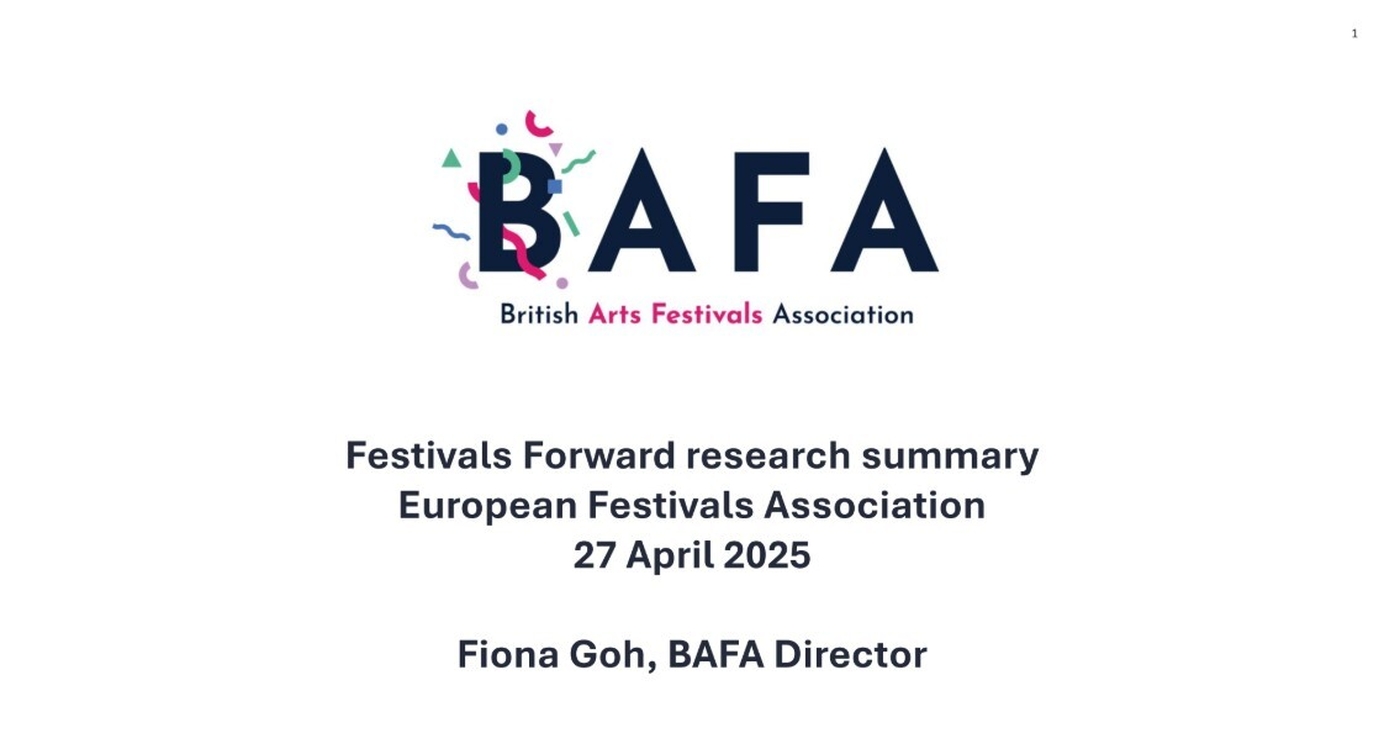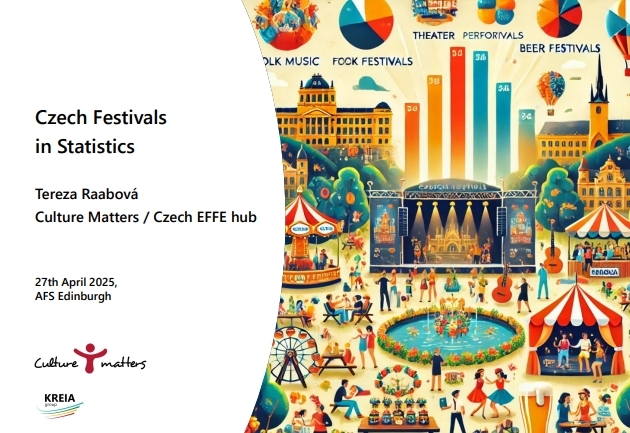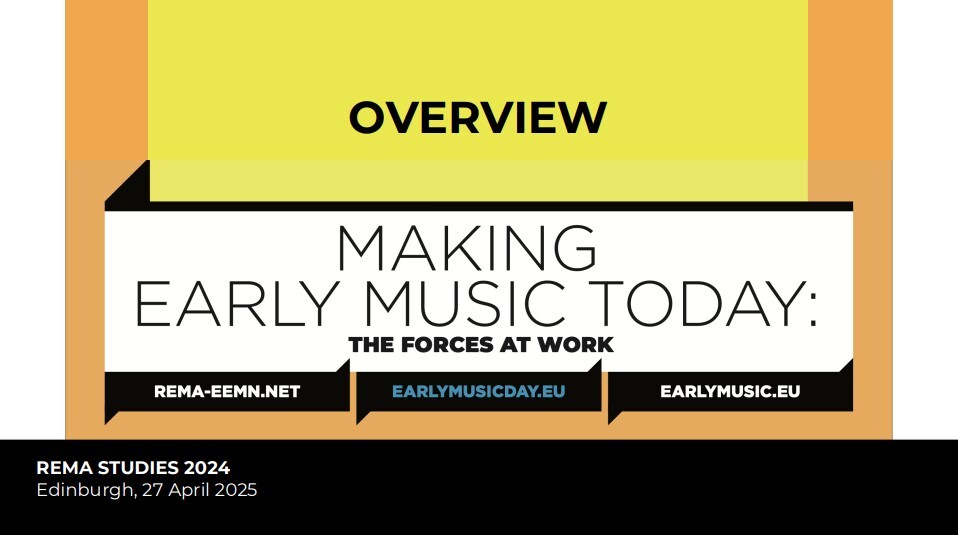Festivals Facts & Figures: Research presentations by EFFE Hubs
Discover some insights from the European Festivals Association (EFA)'s Art Festival Summit 2025: navigate through the data presented at the session Festivals Facts and Figures: Research presentations, presenting the works carried out by four EFA Collective Members & EFFE Hubs.

The Arts Festivals Summit is the European Festivals Association (EFA)'s annual rendez-vous bringing together EFA Members, Alumni of The Festival Academy, EFFEA Festivals and Artists, EFFE Seal Festivals Cities & Regions and more.
In Edinburgh - April 2025, a total of 200 festival representatives, cities and regions, policymakers, artists, and other stakeholders gathered to share experiences and challenges through workshops, thinking groups and speeches - reflecting the EFA network’s continuous endeavour in promoting cooperation and strength within the cultural sector. At the four-day conference, EFA Collective Members & EFFE Hubs conducted a session entitled Festivals Facts and Figures: Research presentations, which presented research conducted in their regions.
Who are the EFFE Hubs - and what is their role?
EFFE Hubs are a vital mechanism for promoting the EFA community and its initiatives at the national level. Active in 31 Creative countries - and covering all European geographical regions - the Hubs play a pivotal role in facilitating broader and capillary engagement with EFA activities in their area of influence and practice, multiplying the effects of central communication. The EFFE Hubs constitute a web of a decentralised pan-European ecosystem of knowledge.
This year's presentations included:
- An Overview of French Festivals in 2024, by Alexandra Bobes, France Festivals
- Festivals Forward: Festivals Mean Business 4, by Fiona Goh, British Arts Festivals Association - BAFA
- Czech Festivals in Statistics, by Tereza Raabová, EFFE Hub Czechia / Culture Matters
- REMA Studies 2024: Making early music today. The forces at work, by Agathe Créac'h, REMA – EEMN
Each of the studies is a portrait of the relative artistic sector framed in our times, in which festivals - as every other cultural activity - have to navigate the challenging waves of unsure financial viability, costs of living, wars, the repercussions of the covid pandemic, challenges of digital innovation, equality, diversity and inclusion, and the increasing impact of climate change, among others.
The data collected and elaborated provide a picture, a state of the art that highlights both opportunities for improvement in the coming years and focused areas of development in the sectors, as well as the common struggles.
For each study section, we invite you to read the full reports via the links provided by the organisations themselves to have a detailed and all-around perspective of the research efforts and their results.

Festivals Forward: Festivals Mean Business 4
Fiona Goh, British Arts Festivals Association
This study gathers data from 101 festivals taking place in 2023 across Wales (11%), Scotland (18%), England (70%) - covering 20 artforms, including science festivals - building on three other national research studies (Festival Mean Business 1, 2 and 3) as a backbone. As an overall statement, the festivals sector is "surviving rather than thriving".
Some highlights:
- Value. In 2023, respondent festivals programmed the equivalent of more than 30 events a day throughout the year. These outcomes are reached despite the small teams that compose a festival organigram: on average, an organisation has 3 full-time equivalent employees year-round.
- Loss-making. Generally, festivals spend more than they make: for 28% of festivals, expenditure rose by more than 20%. For 24% of the festivals, income was reduced by more than 20%.
- An average of 27% of a festival's income comes from public investments.
- Festivals are engines of innovation. Festivals play a key role in investing in artistic innovation and research: two-thirds of responding festivals included new works, commissions and premieres.
- Volunteering effort and social engagement. There is a recurring theme of the sector’s role in providing rich opportunities for personal development. This applies both to its enormous volunteer workforce, paid creatives (often freelance), and audience. "What figures can’t show is the free work beyond paid hours that reflects the very personal commitment that festival teams have to their events."
Festivals strengthen their locality, as festival audiences travel less than 8 km, and 86% of festival organisations run education and outreach activities, including year-round programming.
As the study highlights how the Sector is at a tipping point, we should not forget that thriving festivals mean thriving communities.
“A properly supported festivals sector would create wider ripple effect both into the places and the local communities that festivals serve and the artistic infrastructure that festivals underpin through commissions, artist development, touring and creative collaborations.”
Navigate the organisation's website and its research data now.

An Overview of French Festivals in 2024
Alexandra Bobes, France Festivals
Alexandra Bobes, Director of France Festivals, presented a preliminary overview of the situation for modern, classical, contemporary music, and comedy festivals taking place in France in 2024.
The study observed a structural context affected by increasing climatic variations and budgetary pressure (impacted also by the specific situation of 2024 in France, as the Paris Olympics).
The study highlighted:
- The podium of French regions hosting festivals is: Provence-Alpes-Côte d'Azur (120), Occitanie (110), and Nouvelle-Aquitaine (105).
- Modern music is the number one category for festivals.
- 22% of the festivals are entirely free (on 663 of the respondent festivals).
- The festivals' main difficulties are due to financial issues (59% of the difficulties listed by festivals; 2% of the festivals were cancelled for this reason) and natural hazards (42%).
- The average attendance rate is 78%, and a quarter of the festivals increased their audience capacity in 2024.
- Compared to previous editions, technical, artistic and security expenses have increased, respectively by 58%, 53% and 44% of the festivals.
- More than half of the festivals with an over 90% occupancy rate are loss-making.

Czech Festivals in Statistics
Tereza Raabova, Culture Matters
Tereza Raabova, Director of Culture Matters, presented statistics on Czech Festivals held in 2023, gathering data from a total of 704 festivals. Here is what the study highlighted:
- Music is the predominant art discipline featured in festivals (300), followed by theatre and dance (144) and multigenre festivals (183).
- 43% of the respondents' festivals had an international scope.
- 55% of the festival organisers were NGOs (55%), followed by universities, states, regions, municipalities (31%) and entrepreneurs (14%).
- Festivals for ethnic minorities are slightly increasing after the setback experienced in 2020.
- The total cost for festivals grew by 48% compared to 2019, with the vast majority of funds invested by private institutions.
Click here to have access to the statistical service for the entire area of culture provided by NIPO, on behalf of the Czech Ministry of Culture and in cooperation with the Czech Statistical Office.

REMA Studies 2024: Making early music today. The forces at work
Agathe Créac'h, EEMN/REMA
The study looks at the state of the Early Music sector, gathering the point of view of 79 organisations across 17 countries. It explores the sector’s activities and strategies being implemented, aiming to highlight opportunities for improvement in the coming years and focused areas of development.
From the outside, the sector appears stable at the audience reach levels and at a funding perspective. However, zooming in, the past years' challenges are slowing the development of the organisations, raising concerns about their future.
- Social sustainability
Overall, there is a difference between the promoter and the ensembles’ perspectives, showing non-uniform concerns. It is noticeable a growing discrepancy between the music industry’s stated priorities and perceived challenges, and the actions implemented to address them. Fair and equitable working conditions for artists and employees are set as a priority and active focus of the organisations. There is a rising acknowledgement of the volunteers’ vital role, although facilities dedicated to them remain underdeveloped. The integration of younger generations - both in terms of artists and of audience - is another key point recognised as relevant in line with audience development (socio-economic and cultural diversity of the audience). This challenge is also addressed in considering the role of digital content, platforms and marketing tools. However, the means allocated do not always match the concerns related to audience development: cultural mediation and outreach hold a minor place from a financial and multimedia production point of view.
- Scaling up, scaling down – the thin balance of international & local artists
Promoters’ discourse emphasises attention to the local context, while promoting international outreach to attract artists and ensembles - the greater the international scope of the organisation is, the greater is the shrinking down of the local artists’ presence. The study calls this a Programming paradox.
- Environmental Sustainability
Transport is recognised as the most polluting factor – the use of low-CO2 transport stands out as a stated priority for the sector. At the same time, logistical and technical constraints are the major obstacles to the implementation of environmental sustainability practices. The use of eco-friendly consumables is the most addressed active focus. Together with other environmentally friendly measures as eco-responsible service contracts and waste sorting, are unevenly prioritised, acting on external demands, i.e. local norms rather than being considered as a priority for the sector.
Click on this link to open the official institution page and the study.


